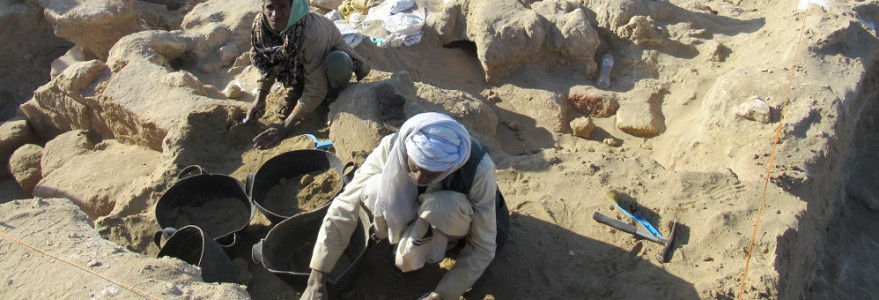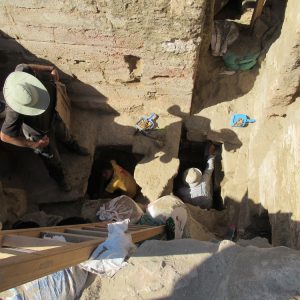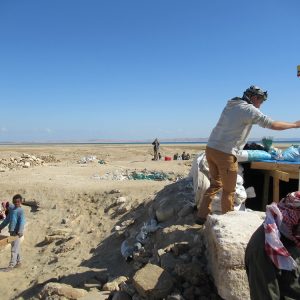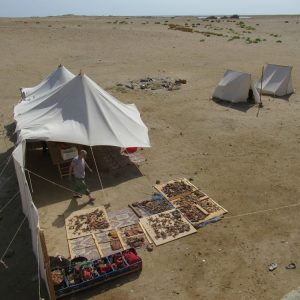Archaeologists from the Polish Centre of Mediterranean Archaeology of the University of Warsaw summarized the effects of the archaeological work carried out in 2020 at the Berenike site in Egypt, as part of the international survey The Berenike Project. Scientists conducted research, among others, in the temple of the Egyptian deities Isis and Serapis, where sculptures referring to traditions known from Asia and the interior of Africa were discovered.
The research was conducted on behalf of The Berenike Project, a joint undertaking of the University of Delaware and the PCMA UW. Within its framework, a number of projects are underway, concerning various parts of this Red Sea port that functioned in the Hellenistic and Roman periods as part of the long-distance trade route between India, Egypt and Rome.
One of the investigated locations (a sub-project run by the University of Heidelberg under a grant from the Thyssen Foundation) was the Temple of Isis and Serapis from the 1st century CE. It is the largest place of worship in Berenike, dedicated to the great Egyptian deities. It was destroyed most probably by earthquakes. “We find traces of ancient Egyptian cults, but with exotic elements from Africa and the Far East,” says Iwona Zych from the PCMA UW, who led the Polish part of the expedition.
Many stone architectural elements and fragments of sculptures, including marble ones, were found in the ruins of the temple. Among them are heads imitating carvings from Asian Gandhara and a large standing statue of the god Sebyu Meker, known from the African kingdom of Meroe (Sudan). There are many images of Serapis, including a rarity: a well-preserved bust made of teak wood. “It was probably made of a broken mast, because this kind of wood was used on ships sailing across the Indian Ocean,” explains Iwona Zych, adding: “The high quality of the sculpture, which was gilded, is astonishing. An accomplished sculptor must have plied his craft on site, in Berenike. It is planned to transfer the sculpture to the Grand Egyptian Museum in Cairo for conservation and display.”
“The excavations in the temple have also shed light on its later, no less fascinating history,” stresses Iwona Zych. There are many indications that, beginning with the later 4th century CE the Blemmyes controlled the harbor both politically and economically. This little-known nomadic Nubian tribe lived in the mountainous Eastern Desert. In the 4th to 6th centuries CE, it had extended its rule to territories east of the Nile, from present-day Ethiopia to Berenike.
Evidence of the Blemmyes’ participation in the life of late-antique Berenike was also found in an architectural complex in the north of the city. It consists of a large building with a courtyard in front of it, surrounded by chapels of various, not only Egyptian, deities. An inscription funded by one Mochosak, an interpreter for the king of the Blemmyes, Isemne, was discovered there. “We know nothing of this man except that he had the power and means to embellish this northernmost outpost of his ruler’s realm in imitation of the great metropolises of the ancient world,” points put Iwona Zych. More blocks with inscriptions have been discovered in the ruins; some are still waiting to be fully exposed, while a geophysical plan of the site shows that there is still a great deal to be discovered underground.
Excavations in 2020 were also carried out at a cemetery of companion animals – another exceptional feature of Berenike.
The Berenike Project in 2020 was co-led by Prof. Steven E. Sidebotham (University of Delaware) and Iwona Zych (PCMA UW). Prof. Marta Osypińska (IAE PAN) is the leader of the animal cemetery grant project. The Berenike Temple Project is headed by Dr. Rodney Ast (University of Heidelberg), Dr. Olaf Kaper (University of Leiden) and Martin Hense (The Berenike Foundation).
More information on The Berenike Project >>







